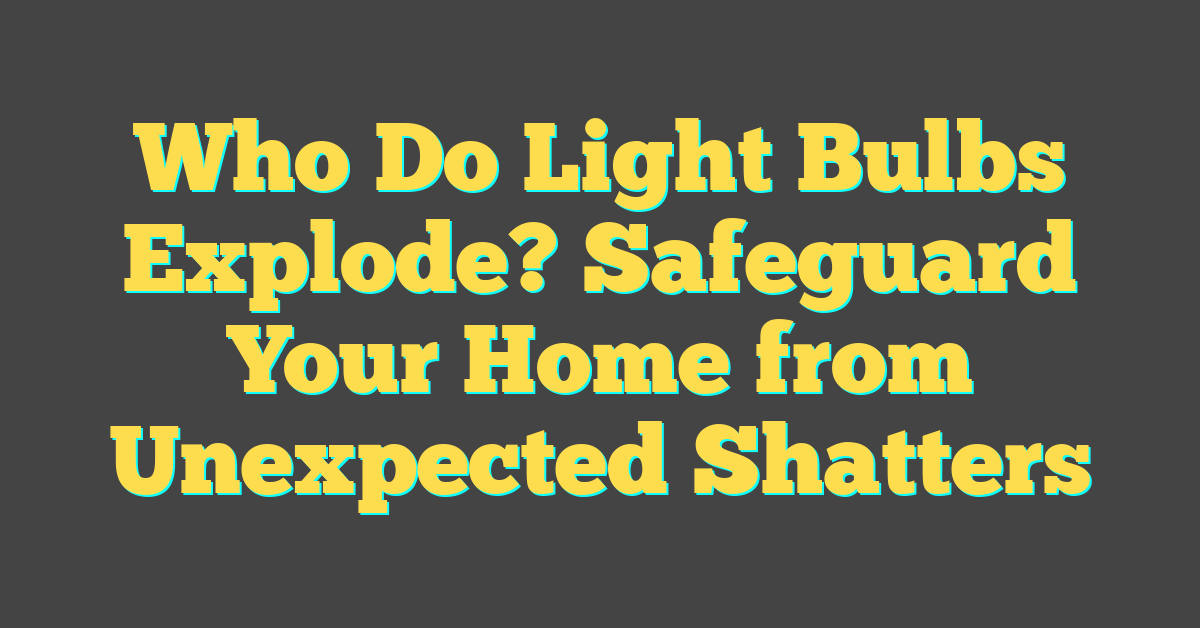Ever been jolted by the sudden pop of a light bulb going kaput? It’s not just startling; it’s downright puzzling. You’re left in the dark, literally and figuratively, wondering why on earth your light bulb just decided to go out with a bang.

Understanding the “whys” behind a light bulb’s explosive farewell isn’t just trivia—it’s about knowing your home’s safety and maintenance. Let’s shed some light on the mystery and uncover what makes these bulbs blow their tops.
The Science Behind Light Bulbs
Diving into the heart of your cozy, illuminated spaces, it’s crucial to understand what makes your light bulbs tick—or in some cases, pop. When you flick that switch, you’re completing an electrical circuit, allowing current to flow through the thin filament in the bulb. This filament, usually made of tungsten due to its high melting point, heats up to an intense degree, glowing and giving off light.
However, tungsten is not just chosen for its heat endurance. When heated, it evaporates very slowly. But it’s this gradual evaporation that can lead to trouble. Over time, the filament gets thinner and more fragile until it can no longer withstand the electric current, and poof—it burns out or, in dramatic fashion, explodes.
But why do some bulbs explode while others simply burn out? The answer often lies in the bulb’s environment. A rapid change in temperature, say from a draft or a splash of cold water, can weaken the glass, leading to a pressure imbalance. This might not seem problematic until you realize that your light bulb is typically under vacuum or filled with inert gas. Pressure imbalances can lead to stress points, and upon reaching a critical level, the bulb can explode.
The quality of the bulb also plays a pivotal role. Flaws in the glass, or in how the filament is secured, can significantly increase the likelihood of an explosion. And though it’s a rarity, power surges are powerful enough to create a light show you’d rather not witness. To give your bulbs a fighting chance:
- Opt for quality bulbs with strong, flawless glass
- Ensure your electrical system is surge-protected
- Avoid exposing bulbs to moisture or drastic temperature shifts
Knowing these factors, you have the power to create a safer, bulb-friendly environment. Remember, the fate of your night-time reading sessions or those warm, ambient light dinners hinges on a delicate piece of metal glowing bravely within a glass sphere.
Factors That Can Cause Light Bulbs to Explode

As someone passionate about DIY and lighting, you’re probably aware that light bulbs are more complex than they appear. While it’s true that all bulbs eventually meet their end, exploding bulbs are a rather dramatic exit that can be alarming. Let’s shed some light on the various factors that might cause this explosive behavior.
First off, overvoltage is a common culprit. Electrical surges can send too much current through the bulb’s filament, causing it to overheat and sometimes burst. Your serene evening can quickly turn into a scene from a science fiction movie if a surge protector isn’t in place. It’s imperative to check your electrical installations or invest in surge protectors to shield your bulbs from these unexpected spikes.
Then there’s thermal shock. Imagine turning on a cold bulb in a hot room or vice versa. This sudden change in temperature can create stress on the glass, leading to fractures and potentially an explosion.
- Maintain a steady room temperature
- Avoid drafts near light fixtures
- Consider LED bulbs, which are less sensitive to temperature changes
But it doesn’t stop there. Manufacturing flaws like thin or uneven glass can make a bulb vulnerable to pressure changes or impacts. If the glass isn’t up to snuff, the smallest of knocks or the slightest pressure fluctuation can spell disaster.
Loose connections are often overlooked but can be just as dangerous. A bulb not screwed in properly can lead to arcing – the bulb acts as a mini Tesla coil, zapping its own glass until it can’t take anymore. Ensure that:
- Bulb fixtures are always secure
- You screw in bulbs firmly but without over-tightening
Moreover, improper handling also plays a part. A drop here, a little moisture there, and your bulb is a ticking time bomb. Being mindful of how you handle and install your bulbs will go a long way in preventing any unwanted surprises.
In essence, illuminating your home involves more than just flipping a switch. It’s about understanding the delicate nature of the technology you’re using and respecting the elements that could potentially turn those quiet nights reading under a lamp into unexpected light shows.
Overheating and Overloading: the Culprits
« Where is Light Bulb on Whirlpool Microwave? Easy Replacement Guide
What Light Bulbs Should You Use in Bathroom? Top Picks for Brightness & Color »

Delving into the world of light bulbs, you’ll discover that overheating is a primary reason for their dramatic demise. Imagine a cozy gathering at your place, light bulbs casting a warm glow, and suddenly, pop! One might blame the bulb, but often, it’s about the environment they’re in. Light fixtures without proper ventilation trap heat, and as you might know, heat and light bulbs don’t mix well.
It’s crucial to check if your fixtures allow for adequate airflow. Ensure that lampshades and enclosures don’t suffocate your bulbs—they need to breathe just like we do. Overheating can not only lead to a burst but also to a short lifespan for your bulb. That’s no good when you’re trying to set the mood for your dinner party or romantic evening.
Overloading, on the other hand, is like forcing your light bulb to run a marathon without any training. It’s when the electrical system delivers more voltage than your bulb can handle. You’ve probably got a lot of gadgets and gizmos at home—each one hungry for electricity. When the demand outpaces the supply, the electrical pressure can get too intense for your little bulb.
Here’s a scenario: you’ve got a bulb meant for 120 volts, but your system is pushing out more, maybe due to a faulty regulator or just a temporary surge. Your bulb’s filament thinks, “This is too much!” and eventually gives up, leading to a light bulb explosion. Not to worry though; there’s a simple fix.
Surge protectors can be your light bulbs’ best friends. They’re like bouncers, keeping unwanted voltage spikes out of the party. Install them at key points where you’ve got multiple appliances or electronics drawing power. It’s a straightforward step, and it pays off by extending the life of your bulbs and keeping your lighting setups safely glowing.
Poor Quality and Defects in Manufacturing

As you dive deeper into the world of home DIY projects, you’ll quickly learn that not all light bulbs are created equal. Poor quality bulbs are more prone to explosion due to manufacturing defects. When a bulb is not made to proper specifications, it can have thin glass or faulty filaments, which make it more susceptible to breaking under stress.
When you’re shopping for bulbs, keep in mind that cheap materials and rushed production processes can lead to inconsistencies. These defects may be invisible to the naked eye but can significantly impact the bulb’s performance and safety. Faulty wiring within the bulb can cause hot spots that lead to shattering, while an improper vacuum (or gas fill within the bulb) can also contribute to a premature end.
- Thin glass: Makes the bulb fragile and likely to break.
- Faulty filaments: Can overheat and snap, leading to potential explosions.
- Improper vacuum: Leads to the presence of oxygen, which can cause the filament to burn out rapidly.
It’s important to choose bulbs from reputable manufacturers who invest in quality materials and rigorous testing methods. These manufacturers often provide detailed specifications for each bulb, including their lifespan and optimal operating conditions.
Remember to check for certifications like UL or ETL, which indicate that a product meets North American safety standards. While it may cost a bit more upfront, investing in quality light bulbs can save you from the hassle and potential danger of a bulb exploding.
Lastly, if you notice any odd flickering or sounds coming from a new bulb, it’s best to err on the side of caution. Remove the bulb and opt for a replacement, ideally from a different batch or even a different brand. Trust your instincts—you’re not just building a home, you’re ensuring the safety of your DIY haven.
Conclusion
So now you’re armed with the know-how to keep your light bulbs in check and your home safe. Remember to give your bulbs room to breathe, protect them from power surges, and stick with quality brands that prioritize safety. If your bulb starts to act up, don’t ignore it—it’s better to be safe than sorry. Stay bright and keep those lights shining safely!
Frequently Asked Questions
What causes light bulbs to explode?
Light bulbs can explode due to overheating, often when fixtures don’t allow enough airflow, or overloading when they receive more voltage than they’re designed to handle.
How can overheating cause a light bulb to explode?
Overheating in a light bulb occurs when the light fixture does not provide sufficient airflow, leading to trapped heat that can reduce the bulb’s lifespan and potentially cause an explosion.
What is overloading and how does it affect light bulbs?
Overloading is when a light bulb receives more voltage than its intended capacity, which can lead to excess heat and pressure, thus increasing the risk of an explosion.
Are surge protectors useful for preventing light bulb explosions?
Yes, surge protectors can help prevent light bulb explosions by managing unexpected voltage spikes and keeping the electrical input within safe limits for the bulb.
How do manufacturing defects contribute to light bulbs exploding?
Manufacturing defects like thin glass, faulty filaments, or a poor vacuum seal can compromise the integrity of a light bulb, making it more susceptible to breaking or exploding.
Why is it important to choose bulbs from reputable manufacturers?
Choosing bulbs from reputable manufacturers is crucial because these companies are more likely to invest in quality materials and thorough testing, reducing the risk of bulb explosions.
What certifications should I look for when choosing a light bulb?
Look for certifications such as UL (Underwriters Laboratories) or ETL (Intertek’s Electrical Testing Labs) as indicators of safety and quality in light bulbs.
Is it a bad sign if a new light bulb flickers or makes sounds?
Yes, odd flickering or sounds coming from a new bulb can be a warning sign of potential defects or incompatibility with your light fixture, and it’s best to trust your instincts and consider replacing the bulb.




